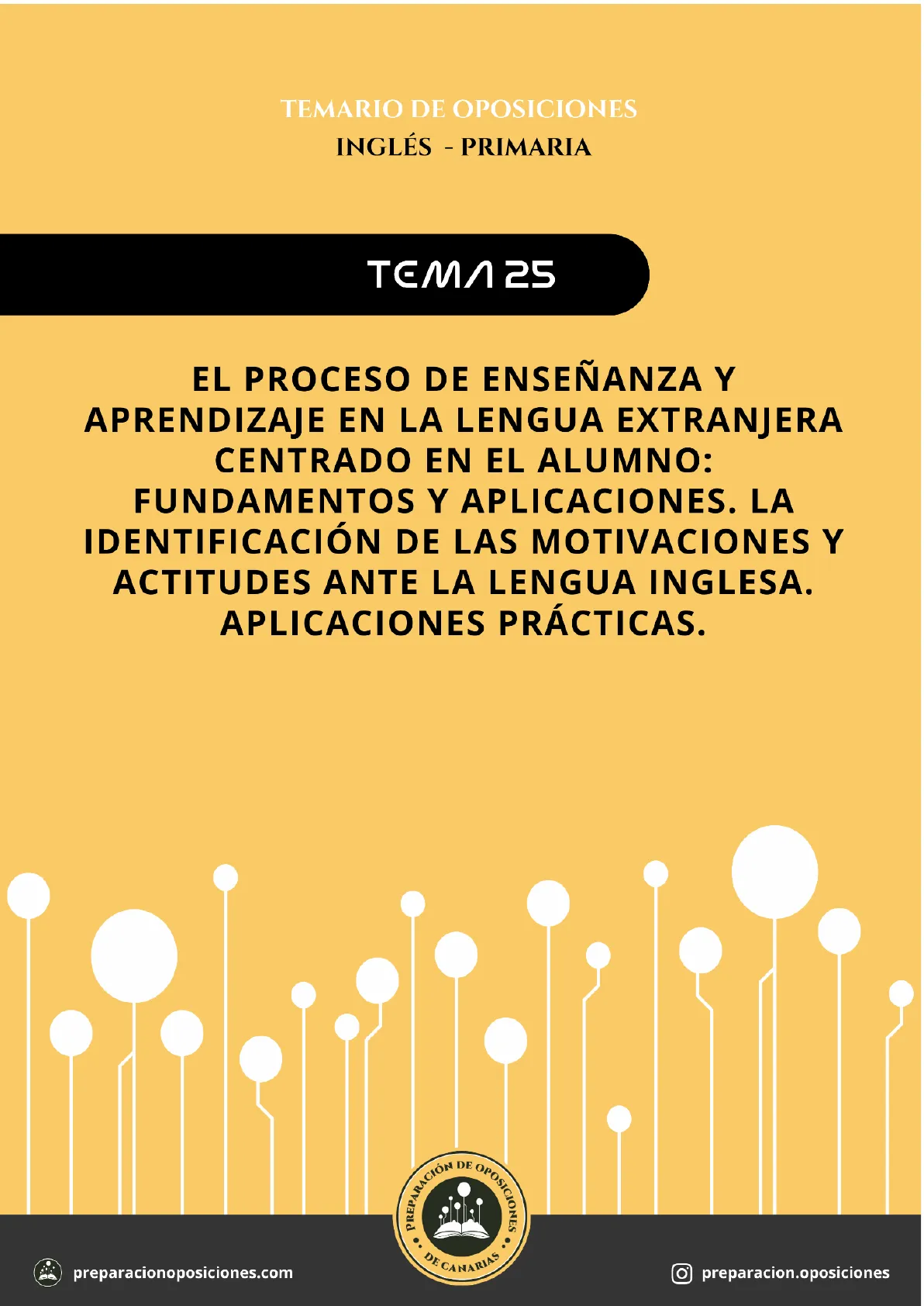Temario de Oposiciones Inglés Primaria Tema 25: Proceso de enseñanza-aprendizaje
Documento de Preparación de Oposiciones de Canarias sobre Temario de Oposiciones Inglés - Primaria Tema 25. El Pdf explora el proceso de enseñanza-aprendizaje de la lengua extranjera, con un enfoque centrado en el estudiante, incluyendo motivaciones y actitudes hacia el inglés, útil para Oposiciones de Idiomas.
See more9 Pages


Unlock the full PDF for free
Sign up to get full access to the document and start transforming it with AI.
Preview
TEMARIO DE OPOSICIONES INGLÉS - PRIMARIA
TEMA 25 EL PROCESO DE ENSEÑANZA Y APRENDIZAJE EN LA LENGUA EXTRANJERA CENTRADO EN EL ALUMNO: FUNDAMENTOS Y APLICACIONES. LA IDENTIFICACIÓN DE LAS MOTIVACIONES Y ACTITUDES ANTE LA LENGUA INGLESA. APLICACIONES PRÁCTICAS.
E OP SICIO PRI NES DE CANARIAS preparacionoposiciones.com preparacion.oposicionesTOPIC 25. THE FL TEACHING-LEARNING PROCESS FOCUSED ON THE LEARNER: FOUNDATIONS AND APPLICATIONS. IDENTIFICATION OF MOTIVATIONS AND ATTITUDES TOWARDS THE FL. PRACTICAL APPLICATIONS.
TABLE OF CONTENTS
- INTRODUCTION
- THE FL TEACHING-LEARNING PROCESS FOCUSED ON THE LEARNER: FOUNDATIONS AND APPLICATIONS.
- IDENTIFICATION OF MOTIVATIONS AND ATTITUDES TOWARDS THE FL. PRACTICAL APPLICATIONS.
- CONCLUSION
- BIBLIOGRAPHY
1. INTRODUCTION
2. THE FL TEACHING-LEARNING PROCESS FOCUSED ON THE LEARNER: FOUNDATIONS AND APPLICATIONS.
Nunan (1991) suggests that the learner-centred approach is based on the idea that learners can learn better when they are aware of their own goals. In this model, students' needs and learning styles are considered before selecting content and teaching methodologies. He divides the curriculum process for a learner-centred approach into several steps: initial planning procedures, content selection and gradation, methodology and ongoing monitoring, assessment and evaluation.
On the other hand, evaluation is viewed as an ongoing process integrated into all stages of teaching and learning; and there are two main components in the learner-centred classroom:
- Students take on more responsibility by managing their own learning (Gibbs, 1992).
- Teachers adopt the main role of facilitators of knowledge to help learners learn how to learn rather than being the only source of knowledge, as in traditional views of FLT.
Besides, we should bear in mind some relevant facts about learner-centred instruction:
- The students construct knowledge through gathering information and integrating it with their previous knowledge, which promotes active learning.
- Knowledge is presented within contexts, so that students can apply it to real-life situations.
- The students' learning is based on active participation, collaboration and cooperative relationships and problem-solving situations.
- Assessment is used to promote and diagnose learning.
- Effective teaching is measured in terms of learner involvement, acquisition of learning objectives and the use of assessment to improve the process.
In relation to learning reflection and its inclusion in the curriculum, we should consider the following aspects: (ESTE APARTADO SE PUEDE PONER PARECIDO AL DEL TEMA 21, YA QUE ES LA RELACIÓN DE FL TEACHING-LEARNING PROCESS, CON EL CURRICULUM)
Stage Objectives: Decree 211/2022
Stage Objectives: The general objectives stated in Decree 211/2022, contain important references to learning to learn and students' reflection. Thus, Objective b) states "Develop individual and teamwork habits, showing effort and responsibility for their work as well as self-confidence attitudes, critical awareness, personal initiative, curiosity, interest and creativity in learning, and an enterprising spirit".
Specific Competences and operative descriptors: (Decree 211/2022)
Specific Competences and operative descriptors: (Decree 211/2022): Specific competences are those abilities that students are expected to demonstrate in activities or situations that requires basic knowledge of each subject area. These competences encompass: comprehension, production, interaction, mediation, linguistics and diversity. The operative descriptors represent the components of each key competence.
Key Competences: Learning to learn competence
Key Competences: As we have already seen in this topic, Personal, social and learning to learn competence refers to the ability to develop an efficient and autonomous capacity to learn. Considering the language as the means of knowledge transmission and the main learning tool, the FL learning clearly contributes to the development of learning to learn competence since it offers opportunities and resources to understand and express feelings and opinions, identify students' strengths for a better learning, face problems, etc. These aspects can be developed through students' learning reflection, cooperation and self-evaluation.
Basic Knowledge: Second language strategies
Basic Knowledge: The official curriculum includes the use of personal strategies and techniques to approach the second language in the three blocks: A. Communication, B. Plurilingualism and C. Interculturality. They are dealing with the use of abilities and procedures (cognitive strategies) such as the use of nonverbal language, repetition, memorization or observation of models; use of information and communication technologies to handle information; and the development of their own capacities to learn a Foreign Language (FL, from now on).
Methodological aspects: Autonomous learning and reflection strategies
Methodological aspects: In this broad component of the programming process, we refer to the guidelines underlying our teaching actions that lead to students' autonomous learning and the development of reflection strategies.
Evaluation: RD. 157/2022 and Decree 211/2022
Evaluation: Evaluation must be parallel to the learning process; and thus, it must be integrated into our teaching actions. Likewise, we have argued the importance of self-evaluation to foster our students' reflection regarding their own learning process and to gain insight into their learning styles and intelligences, so that they can build up on their strengths. The official curriculum, RD. 157/2022, establishes the evaluation criteria for the whole stage of Primary Education. Moreover, these evaluation criteria are specified for our community through the Decree 211/2022.
Scrivener (2005) points out that planning implies imagining the lesson before it happens; and involves prediction, anticipation, sequencing, organising and simplifying.
Following with our path from theory to practice, we suggest some specific activities to promote: Personal, social and learning to learn competence and students' reflection:
How I learn English: Fostering self-confidence
How I learn English: Students bring small photos of themselves and stick them to a paper. Then, with the help of models, they write simple sentences or draw pictureswith information about the things they do well. Through this activity we get children to reflect on their strengths to foster self-confidence.
My favourite style: Reflecting on learning preferences
My favourite style: Given a set of sentences related to things we do in classroom activities, students select which statements adapt best fit their preferences and ways of learning (i.e. "I repeat words in silence", "I translate the words", "I play with word cards", etc). This way, children become aware of the options they usually have available to them and reflect on their own preferences.
Learning diaries: Monitoring progress and strategies
Learning diaries: Learning diaries are particularly useful at the end of a didactic unit to monitor progress and make students aware of the activities they found more difficult and why. They may include statements like: "in this unit I learnt ... "; "I did well ... "; "I found it difficult ... " etc. By using learning diaries, students are provided with a simple framework to reflect on what has been done along the unit and how they managed with classroom activities, the strategies they used, and the like.
3. IDENTIFICATION OF MOTIVATIONS AND ATTITUDES TOWARDS THE FL. PRACTICAL APPLICATIONS.
In the field of FL learning, motivation is widely recognized as one of the key factors that determine the learners' progress. Indeed, motivation serves as the driving force that permits teachers to generate learning and helps learners sustain the long and usually hard journey of acquiring a FL.
Integrative and instrumental motivation
A distinction should be made between integrative and instrumental motivation. The former refers to the desire to identify with and integrate into the target-language culture, while the latter has more to do with learning the FL for studying purposes or career promotion. Similarly, another distinction, perhaps more useful for primary school teachers, is between intrinsic motivation, defined as the urge to engage in the learning activity for its own sake, and extrinsic motivation, more connected to external incentives, like praising a successful performance in the FL.
Attitudes towards learning English (Moon, 2000)
On the other hand, experienced FL teachers are aware of the fact that children do not come to the English lessons like blank sheets of paper, but rather, they have views about and attitudes towards learning English. According to Moon (2000), these attitudes are formed by the social environment in which they grow up and by the people around them. In this sense, it is of utmost importance to be aware of these attitudes as they can influence pupils' desire and motivation to learn and ultimately their success in learning a foreign language.
Factors influencing FL learners' attitudes in Primary Education
In more specific terms, FL learners' attitudes in Primary Education are mainly influenced by the teaching methods, which may turn the FL area into a fun, active and engaging task, by the need to use the FL outside the class (for example, by using the classroom blog to listen to a song) or by personal preferences. It seems clear thatchildren vary widely in their attitudes; however, it is also likely that their attitudes can change according to their experiences. In accordance, the teacher's role is undoubtedly a decisive factor in the development of our learners' positive attitudes and motivation.
Some prime examples may be the selection of appropriate learning materials, planning interesting learning activities and creating a positive classroom environment.
In what follows, we introduce a framework for the implementation of motivational teaching practice, analysing several main elements:
Creation of basic motivational conditions: Carol Read's words (2007)
Creation of basic motivational conditions. In this regard, the FL teacher is in charge of promoting a pleasant and supportive atmosphere in the classroom and cohesive group relations through appropriate norms. There is no shadow of a doubt that the creation of a positive learning environment may be the difference between success and failure in the implementation of an active methodology. In Carol Read's words, "children don't care how much you know, until they know how much you care" (2007). These words entail a whole conception of the teaching action at early ages, in which the volitional factors play a key role, accepting that learning can be more productive and indeed take place more easily when there are positive attitudes. In Read's particular framework, she considers the role of the context in which children will carry out activities, which needs to be relevant and allow for discovery and construction of meaning; the learning coherence, ensuring that the sequence of activities range from simple to more complex and demanding; the development of the learners' curiosity and sense of community, so that children feel challenged, but at the same time supported by the teacher, their peers and accepted by the learning community; and finally care, as children need to feel they are cared about as individuals.
Arousing students' expectancy of success: Dörnyei (2001)
Dörnyei (2001) suggests a simple framework to arouse students' expectancy of success: provide sufficient preparation, offer assistance, peer help, make the success criteria as clear as possible, and provide motivational feedback to increase the learners' satisfaction. It can be achieved through active methodologies that involve communication.
Caring and supportive language: Teacher's role
The use of caring and supportive language, together with a friendly attitude on the part of the teacher, are crucial factors that influence the learners' motivation. These strategies include the consideration of error as a natural and indispensable factor that must be accepted as intrinsic to the learners' construct of the foreign language.
Basic principles for sequencing: Natural Order Hypothesis (Krashen, 1983)
The basic principles for sequencing follow the Natural Order Hypothesis. According to Krashen (1983), students appear to acquire the features of a language in predictable sequences. This natural order operates independently of the sequence in which linguistic rules are taught. The underlying reason for this phenomenon is that learners typically acquire language features by progressing from the simplest to the